The Xiaomi 11T & 11T Pro Review: Two Chips, With a Battery Focus
by Andrei Frumusanu on September 15, 2021 9:00 AM EST- Posted in
- Mobile
- Smartphones
- Xiaomi
- Xiaomi 11T
- Xiaomi 11T Pro
System Performance
The comparison of the Snapdragon 888 to the Dimensity 1200 is interesting as we don’t tend to get to compare MediaTek devices very often. In theory, the Snapdragon has much more oompf to it given its higher performance X1 core, but things also depend on software.


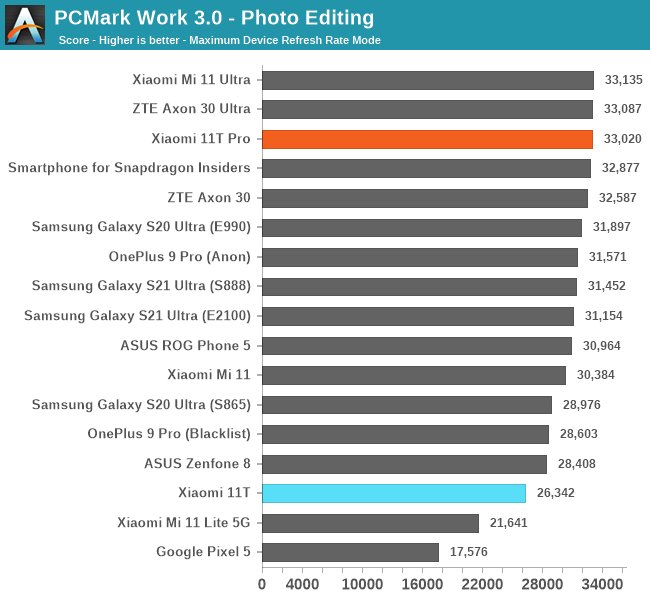
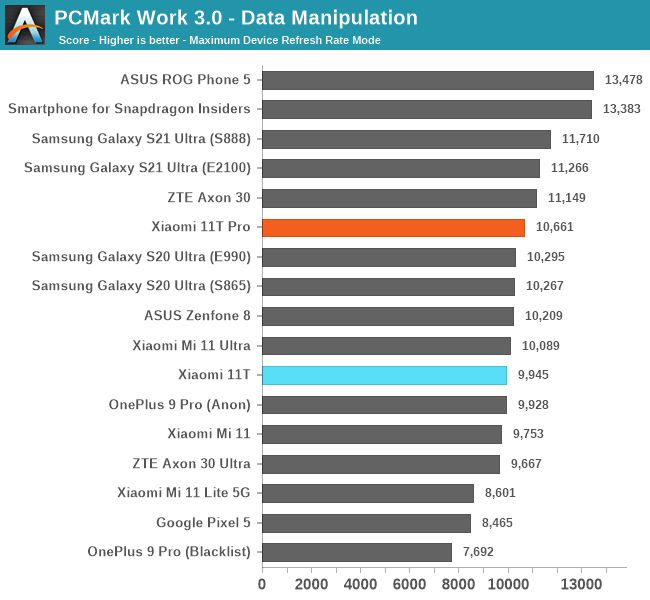
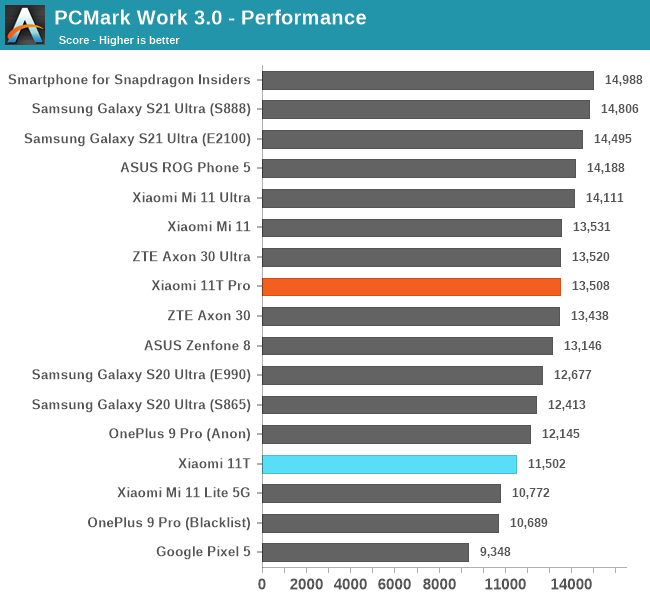
In PCMark, as expected, the Qualcomm powered 11T Pro has no issues in performing quite ahead of the MediaTek powered 11T. It seems that the SoC as well as software stack allows for more aggressive responsiveness on the larger SoC – which is to be expected.
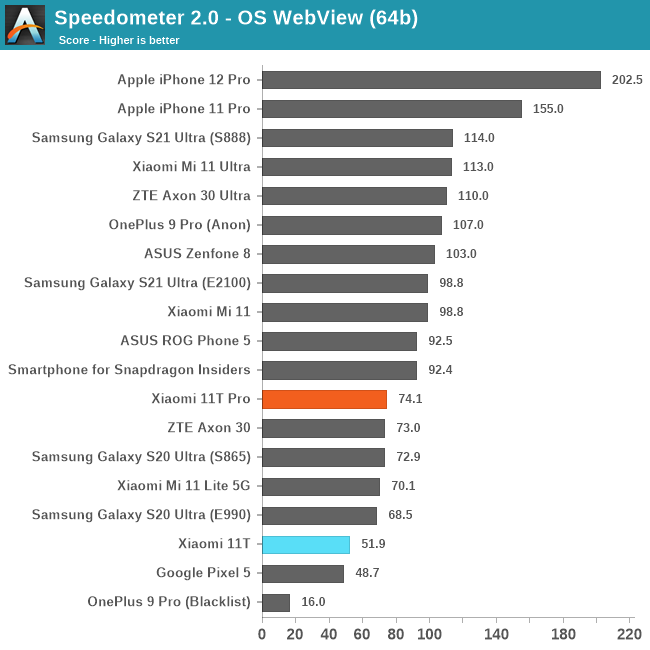
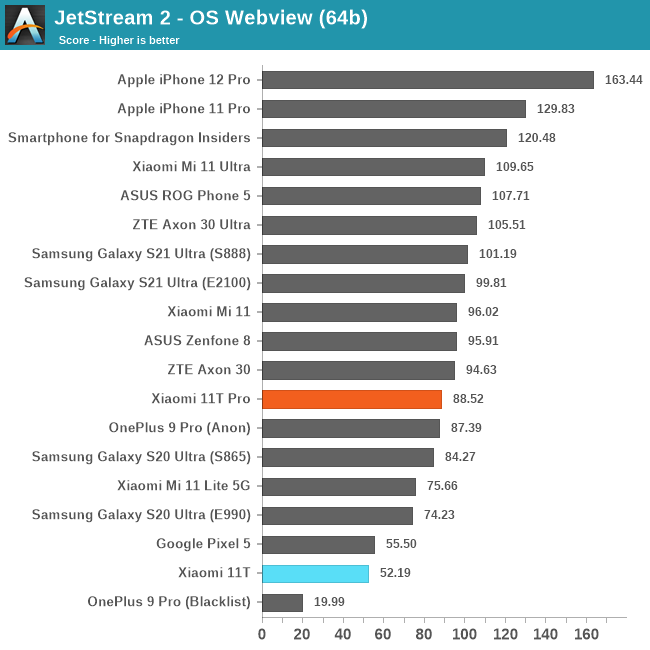
When it comes to the web tests, we also see the 11T Pro easily outperform the 11T, by quite some significant margins even.
What’s a bit weird here is that both devices are actually performing below expectations, and here is where things get very shady:
The Snapdragon 888 in the 11T Pro in these benchmarks is never using the Cortex-X1 cores of the SoC. Instead, pretty much the totality of the tests is being performed on the 2.41GHz A78 cores. If this sounds familiar to you, it’s because we saw some kind of similar behaviour on the OnePlus 9 Pro.
What’s happening on the 11T Pro is that indeed it seems any anonymous workload on the phone is mostly unable to be scheduled on the X1 cores, unless there’s multiple threads which causes spill-over. Without CPU affinity in my SPEC harness, the load gets also scheduled on the A78 cores. If I limit it to just the X1 core, it only goes up to 2.15GHz. In GeekBench, the ST workloads do go up to 2.84GHz even in an anonymised variant of the test, however in the MT load the X1 cores again are limited to 2.15GHz. The X1 cores are still being used here and there in scenarios such as opening apps, but otherwise rarely so.
I can’t really tell if it’s extreme battery optimisation or not, but it’s quite aggressive and the Snapdragon 888 here is definitely handicapped in terms of behaviour.
On the MediaTek Dimensity 1200, the chip fares normally in steady state workloads, however in more interactive workloads such as the above web tests, the DVFS and scheduling behaviour is all over the place with the chip not consistently having the workload on the performance core. I’m also seeing bursts of the other cores needlessly going up in frequency. In general, we don’t have too much experience with MediaTek’s latest software stack, so this would require a bit more investigation, but generally, the phone doesn’t perform quite as well as the raw CPU performance would indicate.
Both phones are fluid at 120Hz, and the 11T Pro is still very responsive, however the 11T doesn’t feel quite as fast.










41 Comments
View All Comments
mingogomes - Wednesday, September 15, 2021 - link
Hey Andrei,On your battery test of PCMark, can you tell me what brightness settings you were using?
Max, 50% or low?
Thanks
5j3rul3 - Wednesday, September 15, 2021 - link
Hope there's more info and review about those extremely fast cahrge system, such as:Oppo
125W / 65W
40W / 30W WL
vivo (iQOO)
120W / 55W / 44W
50W WL
Xiaomi (RedMi, POCO, Blackshark) 120W / 67W / 65W / 50W
80W / 67W / 50W WL
Lenovo
100W
RedMagic
100W / 55W
Qualcomm
100W
HUAWEI
66W / 40W
66W / 40W / 27W WL
RealMe
65W
50W WL
5j3rul3 - Wednesday, September 15, 2021 - link
Adjustment:OnePlus
65W
50W WL
Honor
100W / 66W
50W WL
RedMagic
120W / 100W
ASUS
65W
5j3rul3 - Wednesday, September 15, 2021 - link
Is there any Mi 11T series' camera review?Or just wait iPhone 13 and other smartphones to have a 21H2 smartphone cam battle?
Andrei Frumusanu - Wednesday, September 15, 2021 - link
I didn't have time to do camera, in general expect lacklustre results worse than the Mi 11.Wereweeb - Wednesday, September 15, 2021 - link
IMO a 108MP camera that gets binned down to 27MP is no better than a 48MP camera that gets binned down to 12MP (8.3MP for 4K image + EIS margin). Massive waste of sensor area.(And no, it's not for 8K photo/video, that would require a sensor that gets resolved to at least 33MP)
Plumplum - Monday, September 20, 2021 - link
It's nona-binning...108MP to 12MP...With binning, pixel's size is 2.1microns (3x0.7)
On 48MP, pixel's size is 1.6microns (2x0.8)
Light received by pixel is (2.1/1.6)^2=1.72.
Pixels received +72% light compared to 48MP
I use 50MP IMX766 on Nord 2. Binned Pixel's size is 2.0microns...in low light conditions, it has nothing to do with most 48MP sensors.
Lack of OIS is the weakness on these devices, not sensor.
pfactor - Wednesday, September 15, 2021 - link
From the label, it looks like this charger only achieves 120w output when it is connected to a 220~240V AC supply. (Otherwise, the max output at when connected to 120V AC is only 96W) Was this tested in the US or in Europe?The output rating on the label should be a true output rating, and not a measurement of input power consumed.
ArcadeEngineer - Thursday, September 16, 2021 - link
Andrei lives in Luxembourg, so 230v.Andrei Frumusanu - Thursday, September 16, 2021 - link
I measured 115W on the AC side.